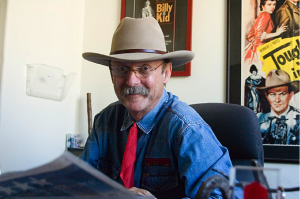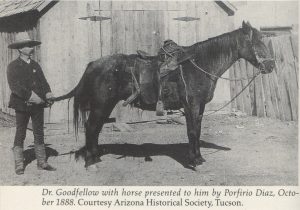A RECORD (IN 6 PARTS) OF AN INTENSIVE AND EXCITING FOUR DAYS OF RESEARCH, STOLEN FROM A FAMILY HOLIDAY AND SPENT IN PHOENIX, TUCSON AND TOMBSTONE ARIZONA.
Day 1 Wednesday Aug 27th 2014. Travel: Grand Canyon to Flagstaff AZ on shuttle bus.; Flagstaff to Tucson in hire car.
Snapshot moment in a car park, waiting for the shuttle minibus: two college-age youths in t-shirts, shorts and matching straw hats stand back to back at ten paces, holding sticks for guns. They take turns to call “Draw!” and whirl round to aim and fire and then claim credit for imaginary hits – “I got you in the neck!” “I hit you in the chest!” etc. I’m in cowboy land.
From Flagstaff I found my way in a hire car without the benefit of GPS to Cave Creek in the outer suburbs of Phoenix, and the offices of “True West” magazine for an appointment with editor Bob Boze Bell, author of a number of books, including two in my possession: separate generously illustrated volumes on Wyatt Earp and his colourful friend, the consumptive retired dentist and gambler ‘Doc’ Holliday.
 The magazine benefits from Bell’s considerable graphic and artistic talents, and has a genuine unsentimental and historical interest at its core, as the title suggests. This may not be entirely the case with the readership: the adverts appeal to a nostalgia for the frontier world of the’ Old West’, which is distinguished in an often blurred fashion from the ‘Wild West’ of the unashamed or ill-informed consumers of the Hollywood myth. Certainly, replica firearms and vintage period clothing feature significantly among the products advertised, alongside adverts for a host of localised museums and auctions of art, photographs and memorabilia. A letter from a reader complaining about the use of the term ‘Civil War’, rather than his preferred ‘War of Northern Aggression’, may not be typical.
The magazine benefits from Bell’s considerable graphic and artistic talents, and has a genuine unsentimental and historical interest at its core, as the title suggests. This may not be entirely the case with the readership: the adverts appeal to a nostalgia for the frontier world of the’ Old West’, which is distinguished in an often blurred fashion from the ‘Wild West’ of the unashamed or ill-informed consumers of the Hollywood myth. Certainly, replica firearms and vintage period clothing feature significantly among the products advertised, alongside adverts for a host of localised museums and auctions of art, photographs and memorabilia. A letter from a reader complaining about the use of the term ‘Civil War’, rather than his preferred ‘War of Northern Aggression’, may not be typical.
The magazine benefits from Bell’s considerable graphic and artistic talents, and has a genuine unsentimental and historical interest at its core, as the title suggests. This may not be entirely the case with the readership: the adverts appeal to a nostalgia for the frontier world of the’ Old West’, which is distinguished in an often blurred fashion from the ‘Wild West’ of the unashamed or ill-informed consumers of the Hollywood myth. Certainly, replica firearms and vintage period clothing feature significantly among the products advertised, alongside adverts for a host of localised museums and auctions of art, photographs and memorabilia. A letter from a reader complaining about the use of the term ‘Civil War’, rather than his preferred ‘War of Northern Aggression’, may not be typical of the readership as a whole!
I sounded Bob out on the subject of guns and he was instantly sensitive to the English perspective, with a certain degree of embarrassment as he interpreted the perspective of some of his fellow travellers and clients: “For a lot of people here it’s in their bone marrow. That’s who they are. When I was at school they closed the school for deer-hunting. It’s their way of life and they hate the f***ing Federal Government for wanting to interfere with it.”
 I was sorry to discover that there were no back issues touching on Goodfellow or significantly addressing the role of the medical profession in the Old West. Perhaps that topic should be earmarked for a future issue. BBB did draw my attention to a photograph of Goodfellow holding the tail of the horse presented to him by the President of Mexico for his services to earthquake victims in 1887: “The guy clearly had a sense of humour”.
I was sorry to discover that there were no back issues touching on Goodfellow or significantly addressing the role of the medical profession in the Old West. Perhaps that topic should be earmarked for a future issue. BBB did draw my attention to a photograph of Goodfellow holding the tail of the horse presented to him by the President of Mexico for his services to earthquake victims in 1887: “The guy clearly had a sense of humour”.
Bell kindly furnished me with some useful ideas and contacts, including a suggestion that I should meet Tim Fattig, another Wyatt Earp author, based in Tombstone. Some of our discussion turned on the difficulty of separating fact from myth in communicating the (often complex and invariably more interesting) history in the face of the public’s powerful appetite for the myth. Famous case in point, the box office hit Tombstone (1993). I had read the prologue of the script in an early draft. It would have taken up to 10 minute’s worth of VO screen time, placing the story in its full socio-historical context – Civil War, Mexican War, mining discoveries, complex legal jurisdictions, a loose confederation of lawless and law-bending incomers into what was then Arizona Territory. This all went out the window when screenwriter Kevin Jarre was replaced as director by George P Cosmatos (Rambo II, Cobra). The new, brief, prologue was long enough to show a gang of evil ‘cowboys’, clearly identifiable by the wearing of red sashes (!), massacre (just for kicks) an entire Mexican wedding as it emerged onto the steps of the church. Yes, perhaps the draft version would have exhausted the patience of the popular audience. After the screened version, we all thirsted to see Johnny Ringo and his gang get their comeuppance. Prologue apart, all inconvenient facts that got in the way of a tale of character conflict and love interest were ruthlessly jettisoned. BBB could not have rated Jarre’s original script more highly: “I feel your pain”.





